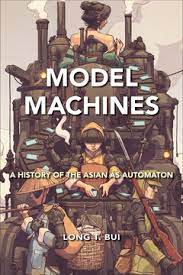Model Machines

Model Machines
- May 4, 2022
- Book by Long Bui, UCI global and international studies, details stereotypes, representations of Asians and Asian Americans throughout history
 In his forthcoming book, Model Machines: A History of the Asian as Automaton, UCI associate professor of global and international studies Long Bui takes a deep
dive into historical stereotypes and representations of Asians and Asian Americans as robotic automatons.
From a case study where a judge likened Chinese immigrants to superhuman machines
to war time examples of Asians depicted as both “sex machines” and “war machines,”
Bui explores how centuries of dehumanizing descriptions and treatment have marginalized
an entire race, resulting in human rights abuses. Below, he details the role globalization,
racism, and colonialism have played in creating and feeding this narrative and how
its effects continue to harm the lives and well-being of people of color today.
In his forthcoming book, Model Machines: A History of the Asian as Automaton, UCI associate professor of global and international studies Long Bui takes a deep
dive into historical stereotypes and representations of Asians and Asian Americans as robotic automatons.
From a case study where a judge likened Chinese immigrants to superhuman machines
to war time examples of Asians depicted as both “sex machines” and “war machines,”
Bui explores how centuries of dehumanizing descriptions and treatment have marginalized
an entire race, resulting in human rights abuses. Below, he details the role globalization,
racism, and colonialism have played in creating and feeding this narrative and how
its effects continue to harm the lives and well-being of people of color today.
Give us some background on where the idea for this book came from. What drew you to focus on what you’ve termed as Asian roboticism or model machines?
In my research on Asian American history, I discovered this strange case of a judge saying Chinese immigrants are mere machines, and therefore should be allowed in the country despite Chinese exclusion laws. He desired them for their superhuman abilities and industrial hyper-productivity. In terms of race and ethnic studies, the stereotype of people as robotic did not figure prominently in the field as representations of them as forever foreigners or model minorities. I had to put a name to that trope and trace its convoluted genealogy so I can understand this better, so I had to define terms like Asian roboticism and model machines.
What do you mean by Asian roboticism and the model minority myth? What stereotypes does this term embody, and how do these characterizations impact the way Asians and Asian Americans are represented?
If the first term (Asian roboticism) generally describes how Asians are given robotic attributes, then the second (model minority) denotes how they are the ultimate kind of human machines. All these processes impact Asians and Asian Americans by further dehumanizing them, things to be exploited and eventually disposed of. We see this myth of Chinese workers in China’s manufacturing factories today or as “coolie” laborers in the nineteenth century are treated as cogs. A lack of recognition of Asian humanity thing can appear in a range of forms, from skilled classical musicians or test-acing college whiz kids. These representations appear around the world, including Asia, but I found them most prevalent in the United States. The global archetype has been around for centuries, so predates the model minority myth that says Asian Americans are exceptional at work.
Align for us this notion with the case studies and occupations your book focuses on. What role have globalization, racism, and colonialism played in creating and feeding this narrative? And at what cost?
By discussing the history (and enduring impact) of what I call the model machine myth, I am documenting the imperial expansion of the United States. The life-giving myth of American exceptionalism and empire relies on other myths about the non-white foreign “Other. Colonialism extends the racial project of treating others as less-than-human, such that can roboticization of races” justifies the narrative that these alien beings are not like “us”—and we should therefore conquer or destroy them. Such thinking invites all types of social abuses, marginalization, and genocidal logics. Discourses from public health, academia, the law, military propaganda, and popular culture continue to feed into this opinion of Asians and people of color as in/sub/alt-human. My work on Asians inspired me to even write about the rendering of Latinas in Mexico as inexhaustible cyborgs, which was published as an article!
The pandemic has brought with it a surge in anti-Asian and Asian American hate crimes. What lessons does your historical review in Model Machines teach us about forging a better future?
The huge spike in anti-Asian violence during the Covid-19 pandemic tells us that the human-nonhuman dynamic remains operative in these times. Asians are still seen as inhuman or subhuman. To move toward a more humane future demands imagining alternative humanities, one where a past record of gross dehumanization (as seen in the book) is not forgotten but informs our inchoate grasp of a “posthuman” just world. The history of race overlays with the history of robots. To consider high-tech societies run on artificial intelligence requires us to reckon with unequal social systems centered on an “artificial humanity.” Myths and especially model machine myths I believe will continue to shape our global sense of the possibilities and limits of the human.
Share on:
Related News Items
- How a Top House Race Became a Fight Over Communism, Immigration, and Asian American Identity
- Derek Tran says he's fluent in Vietnamese. Rep. Michelle Steel's campaign says he's not.
- Viral World: Global Relations During the COVID-19 Pandemic
- OC's Little Saigon voters went for Hillary Clinton, then Donald Trump. What about 2024?
- In war saga 'The Sympathizer,' Vietnamese voices are no longer stuck in the background


connect with us: